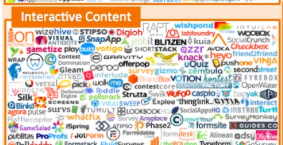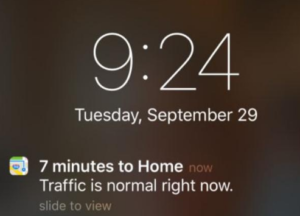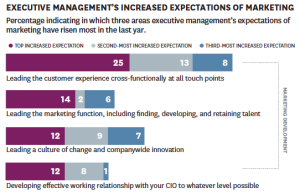by scott.gillum | Aug 12, 2016 | 2016, Marketing
This summer we gave our intern, Paige DiPerte, the herculean task of helping us make sense of the constantly expanding universe of MarTech. In this post, Paige gives us a glimpse into the world of interactive content, and identifies some providers to check out. 
It’s no secret that engaging content creates more value for users and extends their loyalty as customers, and the vanilla content of whitepapers, eBooks, or infographics is not cutting it.
Even though Buzzfeed quizzes tend to be kitschy, these methods of engagement consistently are listed as “Trending” on the site. From finding out which Harry Potter character died last to learning instructions for how to operate a device, users are choosing engaging content like assessments, calculators, polls, brackets, and interactive videos. It’s not a surprise that DemandGen shared in 2016 report that 84% of B2B buyers prefer interactive content, while 83% want content to be more interactive.
This rise of active and personal learning puts users in a place to engage with content and then make informed, substantive decisions. This powerful form of absorption is beginning to shape marketing consumption into a constructivist framework.
At the same time, behind-the-scenes, marketers are donning the white coats of realists. Careful observation and analysis of the data gleaned from interactive content is a marketer’s gold mine.
Traditionally, marketing can infer a user’s “digital body language” from a footprint of website history, clicks, downloads, and emails opened to generate lead scores and segment labels. Problems, however, arise both in communicating intent through the data and in the traffic between marketing automation platforms (MAPs) and CRM tools.
The emergence of marketing apps has created a new divergence in lightweight, usable tools to deliver “microservices” for interactive content. And no, this isn’t an app like Instagram. Marketing apps are web-based and don’t require installation, can work on any device, and can be published or taken down at any time without the constraints of AppStore.
Not only do these marketing apps implicitly engage users, breed more enthusiasm, and feed users more memorable information, but they also supply brands with the very data that allows them to know their customers on a more personal level. If you score wrong on a quiz, it tells marketing what you don’t know. If you calculate your ROI, you are providing sales with the metrics of your business.
The stars of interactive content understand that it’s not all about the data, though. Vendors like Ion Interactive and Ceros allow marketers to create tools without any programming background. This eliminates cookie-cutter polls and quizzes, allowing them to customize their tools directly for their customers that they know and understand best.
Right now this means that active learning is intertwining with the data-based realism to deliver leads in more interactive ways. So what’s your excuse for not using them?
Paige DiPrete is a rising junior at Georgetown University studying Global Business and Portuguese. As an account service intern at gyro in Washington, D.C., she manages agency-client communication and researches MarTech insights.
by scott.gillum | Jul 27, 2016 | 2016, Marketing
A few weeks ago, I participated in an interview with CEB‘s new Marketing Solutions group. The focus of the article, as they described it, was to “understand what it takes to have a healthy client-agency relationship.”
The article was published in their July monthly newsletter to members. CEB was kind enough to allow me to share an excerpt of the article with my readers (see below).
We asked agency leaders from key partners in CEB’s recently launched Marketing Solutions* effort to answer the question “What key relationship-building steps do clients most often overlook?” Below you’ll find our curated list of top overlooked steps:
- Make Sure They “Get It”: No matter how well the agency knows your industry, there needs to be discipline on both sides, ensuring the agency invests time getting to know your business, customers, brand, and the expectations of key stakeholders.
- Keep the Creative Spark Alive: Saying “no” too many times or being too directive can kill a client/agency relationship. You’re looking for a fresh perspective, not a passive, tactical partner. Challenge your agency to do at least one wildly strategic or creative thing for you each year, something that might even make you a bit nervous.
- Be Constructive: Creative teams invest time in understanding a clients’ issues/objective and then brainstorm on possible solutions. Keep in mind that it’s not what you say, because agencies need your input, it’s how you say it. First be complimentary, what you like, and then give notes.
- Don’t Miss the Magic: Too often RFP’s are focused only on qualifications and price. The real magic in an agency relationship is how well you work together. Be mindful of the way your teams will work together—and bring out the best in each other—that will really make a difference.
- Understand Limitations: A good creative campaign can change perceptions about your brand, products, and even service capabilities. However, it is the burden of the organization to deliver on the “promise” being communicated. Be realistic of what your agency partners can and cannot solve for.
- Agency’s Ability to Help You Bust Internal Silos: Assess agency candidates for their understanding of key partner functions (like sales, service or operations) and their ability to help you bring those other partners into creating seamless customer experiences.
- Agency’s Ability to Disrupt Your Customers: Winning marketing efforts disrupt what customers think, believe, and assume about themselves (not about you). Bottom line: pressure test your agency’s empathy—the ability to go deep into how customers think about themselves and their own world.
Additionally. CEB is now providing execution support on B2B go-to-market messaging and content creation. They’ve partnered with select agencies, like gyro, to offer engagements that help create messaging and content that reflect the latest insights from CEB’s B2B buyer and best practice research If you’re interested in learning more, send me a note.
by scott.gillum | Jun 16, 2016 | 2016, Sales
I’m a “binger.” I’m “all in” when it comes to consuming content and I’m not alone. Netflix reports that of it’s 40 million US subscribers, over 60% report being “binge watchers.” We also know that our personal habits influence our professional habits, so could there be a group of “binge buyers” who are currently being underserved with our content efforts, and could that be hurting our sales efforts?

For example, I’m working with a client to help them “digitalize” the organization. As part of the effort, I’m evaluating software tools to help improve the performance of their content marketing efforts. So I’ve been binging on vendor content, going deep into their sites and watching hours of video to evaluate their fit for our client’s needs. However, one of the vendor’s limited the information on their site forcing me to request a demo to learn more about their tool.
Ten days after I requested the demo the vendor finally reached out to me. It then took another 3 days to align our schedules. The day of the “demo” was disappointing. I didn’t get to see the tool, but instead I got a 10 page powerpoint pitch. Running out of time that day forced me to set up yet another call more than a week away. Needless to say, they didn’t make the short list of vendors to consider.
Here’s the point we know from CEB, Sirius Decision, and Forrester decision makers are more than half the way through the buying process before they engage a sales person. If you are an organization that is trying to insert a sales person in upstream, you run the risk of slowing the buying process and/or being eliminated from it.Your prospects maybe “bingers” like me. Let them go deep and gather all of the information they need on their own. It will accelerate your sales cycles, increase lead volume, and lower the cost to sell. I know it will set off alarms with your lead tracking process, but the fact is, buyers control the process and they will let you know when they need to talk to someone.
Still skeptical? Atlassian, an open source provider of project management and app software sold over $300 million in enterprise software without a single sales person. The keys to their success: a great product, word of mouth and letting buyers sell themselves. “Customers don’t want to call a salesperson if they don’t have to,” says Scott Farquhar, Atlassian’s co-chief executive officer.
“They much rather be able to find the answers on the website.”
Don’t get me wrong. I believe sales people can serve a very valuable role for the buyer, and for organizations. But that role has shifted, instead of being the product “spokes person” they should now focus on better understanding what information buyers need to drive a consensus on a decision within their organization.
Unsatisfied with my first call with the rep that left me without seeing the tool, I found a product demo video on Vimeo. I doubt they even knew it existed, so by second call, I was already well versed on the tool. I knew how it differed from the other tools being evaluated, but what I didn’t know was why my client would need that functionality. That is where the sales person could have been helpful, and could of earned themselves a shot at the sale. The lesson; bingers are out there and growing, if you throttle bandwidth on content you could be limiting, or in this case, eliminating opportunity.
by scott.gillum | May 17, 2016 | 2016, Marketing
 One morning a couple of months ago I got in the car and my phone said travel time to my office 20 minutes and traffic was normal. A new feature of iOS9 is the ability for Apple Maps to detect when you enter your car by syncing with Bluetooth. I didn’t find it invasion, in fact, living in one of the worst cities in the country for traffic, I welcomed the information.
One morning a couple of months ago I got in the car and my phone said travel time to my office 20 minutes and traffic was normal. A new feature of iOS9 is the ability for Apple Maps to detect when you enter your car by syncing with Bluetooth. I didn’t find it invasion, in fact, living in one of the worst cities in the country for traffic, I welcomed the information.
Now that I’ve had a taste of IoT and “things connecting to things” I want more, and it’s given me a glimpse of what the future of mobile advertising might look like. Ads will go from being disruptive to being useful, perhaps even helpful. Mobile devices will become your digital doppelgänger signaling to other devices your presence, preferences and patterns.
For example, I’m on my way to LA for a meeting. My United app holds my flight itinerary, terminal and gate, Google/Apple Maps knows my current location, and my Starbucks app knows my buying behavior. My phone holds my intent, location and past purchasing history that could trigger opportunities to give me promotional messages as I journey to my gate.
Given the early morning departure, I’m in desperate need of coffee. The wall-mounted screens on the “people mover” (in the future) could flash me offer as I pass, inviting me to stop at a convenient store location by my gate. In this new world, my order would be ready and waiting for me when I arrived. Being between two locations, and missing the closest one, I would of appreciate this information as I have no time to backtrack.
Here’s the point — we are quickly moving to the ultimate marketing goal of getting the right message, to the right person, at the right time, and in the right place. But to enable this future, which will be data driven and permission based, the challenge for marketers is — how do we enbable it and/or keep from screwing it up?
Here are four things to consider:
- Retargeting – we have to stop being “creepy” by being better at targeting and knowing when to turn the “switch off.” Enough said on this topic, I think we all know the issues. Trying to be “personal” without having a relationship will get you into trouble.
- Overemphasizing Acquisition – IAB reported that digital advertising increased by 20%, and mobile by 66%, in 2015. Yes, there are certain elements of digital that deserve the investment, but attribution issues still exist. Take a hard look at your revenue mix and understand the most productive lead sources. Place your bets on improving conversion metrics, not just increasing volume. Don’t create a bunch of unnecessary noise at the top of the funnel.
- Undervaluing Upsell, Cross Sell and Renewal – With a future built on “permissions” existing relationships are the perfect starting point. Invest in helping customers become better consumers by thinking for them. Reposition marketing activities from being interruptive to being helpful, innovative and informative. Proactively reach out to them with offers based on their behaviors, focusing on how it will help them in their role, and not necessarily how it directly benefits your organization. Trust me, it will come back to you.
- Scrutinize Technology Investments – ChiefMarTech estimates that there are now over 3500 MarTech providers. It’s a “killing field” as Larry Ellison once described it. Over the next 2-3 years companies will either 1) run out of money, 2) merge or 3) be acquired. Carefully consider and select partners that will help build new mobile platforms, capabilities and tracking. Invest the time to get to know their business/funding model, existing customer base, and account team.
In the near future, highly personalized ads will spawn in real time based on consumer’s intent and location… and they won’t just appear on devices. Let’s hope that point arrives soon. I really could of used that Grande Dark for the plane ride. Airline coffee may say it’s Starbucks, but it really doesn’t taste the same.
by scott.gillum | Mar 31, 2016 | 2016, Marketing
Organizations are spending millions of dollars to “digitalize” themselves, as a way to become more agile and responsive to customer needs. As Gartner says, “Companies should be able to ‘react at Internet speed’ with real-time analytics to better understand individual buyers, and how to serve their unique needs.”
The payoff of these efforts is a more competitive and innovative organization that provides a consistent and engaging customer experience. As the organization become flatter and more transparent, it also brings a certain degree of risk. And, increasingly, that risk is falling on one group.
Yes, you guessed it: marketing.
According to HBR’s Designing a Marketing Organization for the Digital Age report, marketing is not only responsible for creating a consistent customer experience across the enterprise; perhaps even more challenging, it’s responsible for getting the organization to embrace change.

Ramping up the organization to operate at the new “Internet” speed of change is critical, according to McKinsey’s Cracking the Digital Code global survey. Forty three percent of executives surveyed said that high-performing digital companies go from idea to implementation in less than six months.
And let’s not kid ourselves about the herculean effort this may involve. Twenty five percent of executives who participated in the survey expressed concerns about their organization’s ability to keep pace, and its ability to adopt an “experimentation” mind-set required to make this transformation.
Marketing is, however, well equipped to take on the challenge; it has always advocated for customers and their experiences. Now it’s being empowered to take ownership of it across the entire enterprise. Marketing has long been the “tip of the spear” for digitalization, operating as the “hub” of digital interactions with customers for years. No other group has had to embrace and operate at the “speed of the Internet” like marketing has.
So it’s not surprising that 75 percent of marketers expect to be responsible for the customer experience, according to the Economist Intelligence Unit.
If marketers can successfully bring about the change needed to digitalize the organization, it should also yield additional organizational benefits that go beyond the customer experience. For example:
- Improving the culture. 89 percent of senior executives said that great companies build cultures that consistently create excellent customer experiences. Corporate culture also plays a critical role in attracting and retaining digital talent, according to McKinsey.
- Aligning customer service to the brand message. Although this has been discussed for years, companies are increasingly aligning the performance of customer service to brand health metrics, according to the HBR report. The Aberdeen Group also noted that when customer service is in sync with how marketing manages the brand, company revenues rises, as do social media mentions.
- A new organizational model. According to Frank van den Driest, author of The Global Brand CEO: Building the Ultimate Marketing Machine, in a digital world, marketing will evolve from expertise in “things” like television, ecommerce and media, to “thinkers” who excel at understanding and using data, “feelers” who are immersed in customer behavior and interaction, and “doers” who implement campaigns, creating content and measurement.
Given the importance of this digital transformation, improving the customer experience is now the No. 1 CEO expectation of their chief marketing officer, according to Gartner. For years, marketers have been asking for a seat “at the table,” and now they have it…and it’s a hot one.










